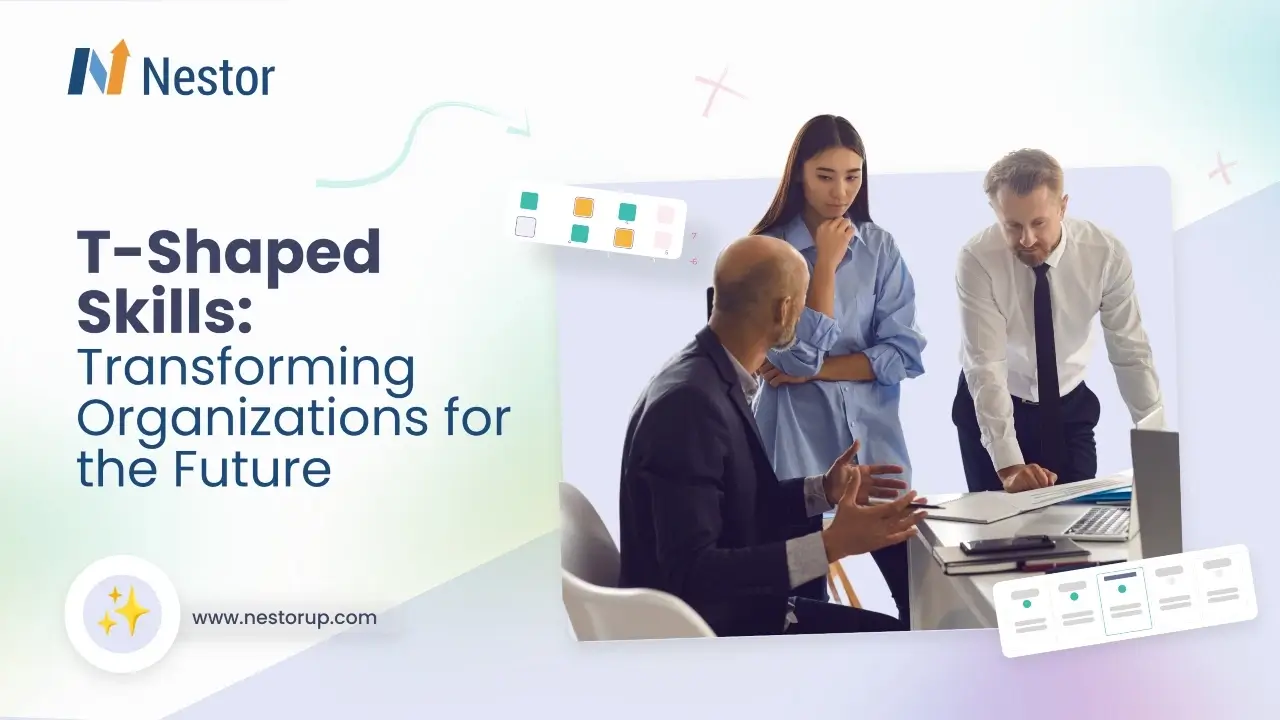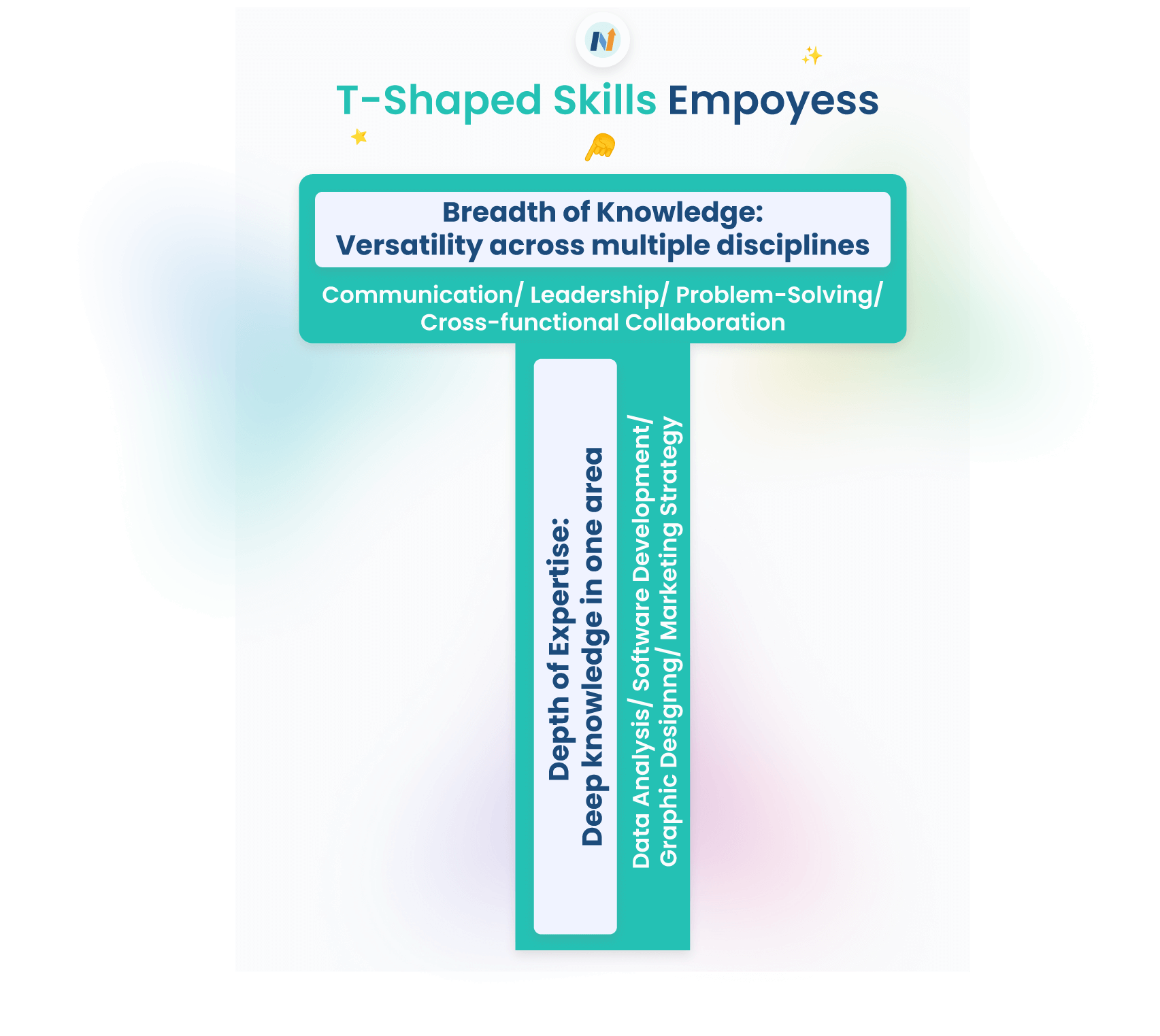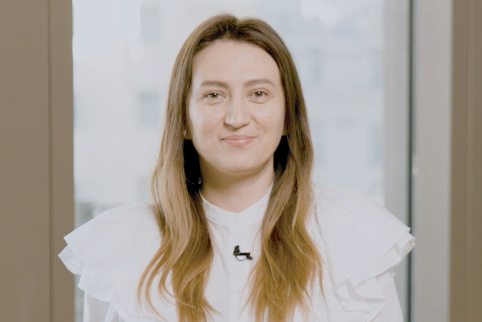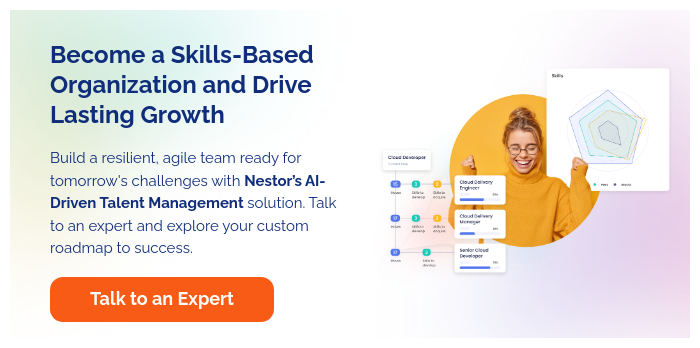
Contents
The workplace isn’t getting simpler. Every day, professionals face new challenges that demand more than just technical expertise or general know-how. Thriving in such a complex world calls for a special kind of versatility; one that combines deep expertise in a single area with a broad set of complementary skills. This unique blend is known as T-shaped skills.
What exactly are T-shaped skills? Imagine the letter “T.” The vertical bar represents your depth of expertise in a specific field. It’s what you’re truly exceptional at, your specialty.
The horizontal bar is your breadth of knowledge across other areas, skills like communication, leadership, and adaptability. Together, they create a profile that’s balanced, flexible, and highly effective in modern workplaces.
Why do T-shaped skills matter so much? Because they make you adaptable in ways that a singular focus cannot. They allow you to dive deep when needed and bridge gaps between teams or disciplines. The importance of T-shaped skills is not just anecdotal.
87% of executives report skill gaps in their workforce or expect them within a few years.
— McKinsey Global Survey
These gaps are widening, and many organizations are struggling to close them. In fact, the same survey found that only 28% of companies feel equipped to address these gaps effectively.
So, how can businesses bridge these gaps? T-shaped skills are the answer. By investing in versatile professionals who combine deep expertise with a broad knowledge base, organizations can address skill gaps and create teams that are agile and capable of solving complex problems.
But how can organizations cultivate these valuable T-shaped skills? And what specific benefits can businesses expect from investing in this approach to talent development?
If you’re looking to future-proof your organization, this article will walk you through what T-shaped skills are, why they matter, and how to build them into your workforce.
The Anatomy of T-Shaped Skills

T-shaped skills form the foundation of versatility in modern work environments. While the concept is simple, the application is anything but. Let’s dissect its components to see how they empower professionals.
The Vertical Bar: Nurturing Deep Expertise
The vertical bar of the T represents deep, technical expertise. This is the foundation of any professional’s value—the area where they’re considered a true expert.
For instance, consider a marketing professional in your team with deep expertise in digital analytics. This employee doesn’t just understand basic metrics; they can dive into complex data sets, extract meaningful insights, and translate them into actionable strategies that drive your company’s growth.
Why does depth matter? Deep expertise provides credibility and the technical foundation needed to handle specialized, complex tasks. Without it, professionals may struggle to deliver high-quality work in their core area.
However, vertical skills alone can lead to silos. A marketing professional with deep expertise in social media but no knowledge of branding or sales won’t contribute effectively to a larger strategy. That’s where horizontal skills come in.
The Horizontal Bar: Fostering Cross-Functional Understanding
The horizontal bar of the T provides the adaptability and connectivity modern workplaces demand. These are the skills that allow professionals to bridge gaps, work across teams, and contribute beyond their specialization. They include:
- Soft Skills: Communication, leadership, emotional intelligence.
- Cross-Functional Knowledge: Awareness of related disciplines, such as a designer understanding coding or a project manager knowing finance basics.
- Adaptability: The ability to quickly learn and apply new skills when business needs shift.
Let’s return to our digital analytics expert. With T-shaped skills, this employee would also have a working knowledge of areas like customer experience, product development, and even finance.
Contrast with Other Skill Sets
To fully appreciate the value of T-shaped skills, it’s helpful to contrast them with other common skill sets you might find in your organization:
I-Shaped Skills: Deep Specialists
These represent the traditional specialist model. An I-shaped professional has one towering strength: depth in a specific field. For instance, an engineer who is a world-class expert in circuit design but lacks leadership or communication skills.
- Strengths:
- Their expertise is unmatched.
- They’re critical for tasks requiring technical precision.
- Limitations:
- They can’t easily adapt to new roles or industries.
- Collaboration with other teams may be difficult.
While these employees can be invaluable for solving complex problems within their domain, they may struggle to collaborate across departments or adapt to changes outside their area of expertise. Over-reliance on them can lead to rigidity and poor cross-team communication.
Dash-Shaped Skills: Generalists
Dash-shaped professionals have broad, generalist knowledge across many areas but lack deep expertise in any one field. Think of a general manager who knows a little about HR, marketing, and finance but isn’t an expert in any one area.
- Strengths:
- They’re adaptable and quick to learn.
- They fit well in roles requiring coordination or oversight.
- Limitations:
- They may lack the authority or technical skill needed for specialized work.
- They risk being seen as “a jack of all trades, master of none.”
You’ll benefit from dash-shaped professionals in middle management or early-career roles, but these employees often hit a ceiling without deeper expertise.
π-Shaped Skills: Dual Specialists
π-shaped professionals combine two deep areas of expertise (the two vertical bars of the π) with generalist skills (the horizontal bar). For example, a marketer who excels in content strategy and data analytics, supported by strong communication skills.
- Strengths:
- They’re highly versatile and suited for leadership roles.
- They bring valuable interdisciplinary insights.
- Limitations:
- It’s challenging to maintain deep expertise in two areas.
While π-shaped skills are powerful, they require a significant investment in training and development to cultivate. Employers must recognize their value and support their growth.
Comb-Shaped Skills: Multi-Specialists
Comb-shaped professionals have expertise in multiple areas, each represented by a vertical bar in their skill profile. A product manager with strong knowledge of UX design, coding, and marketing is a good example.
- Strengths:
- Perfect for highly complex industries.
- Able to contribute meaningfully across multiple disciplines.
- Limitations:
- Maintaining deep knowledge in many areas can lead to burnout.
Employers may find comb-shaped professionals valuable in leadership or niche roles, but they’re rare and resource-intensive to develop.
Why T-Shaped Skills Matter
Now that we’ve explored what T-shaped skills are, let’s dive into why they’re important. In fact, 84% of companies now use a T-shaped skills model for talent management, recognizing its value in fostering both deep expertise and cross-disciplinary collaboration. So, let’s explore the specific benefits of T-shaped skills:
Individual Impact
Employees with T-shaped skills are uniquely positioned to contribute beyond their primary roles. Their combination of deep expertise and broad knowledge allows them to:
- Solve Problems Holistically: Instead of approaching challenges from a single lens, T-shaped employees integrate insights from various disciplines.
- Take Initiative: Employees with horizontal skills are better equipped to notice and act on opportunities outside their usual domain, fostering a proactive work culture.
- Adapt to New Roles and Responsibilities: In dynamic industries where job roles evolve, T-shaped employees transition more smoothly because their horizontal skills provide flexibility.
For employers, this translates into higher productivity, fewer gaps in project execution, and an empowered workforce that drives innovation.
Team Impact
In any organization, collaboration is key. T-shaped employees excel at bridging gaps within teams, leading to:
- Improved Communication: Their breadth of knowledge makes it easier to communicate with colleagues across departments.
- Cross-Functional Synergy: T-shaped employees don’t just work in silos; they act as connectors. They help ensure that teams like finance, operations, and product development are aligned in their goals.
- Conflict Resolution: With a broader understanding of multiple disciplines, T-shaped professionals are better equipped to mediate disputes or misalignments between teams.
For employers, fostering T-shaped skills within teams leads to fewer miscommunications, better collaboration, and a unified approach to achieving organizational objectives.
Organizational Impact
The modern business environment demands rapid adaptation to changing markets, technologies, and customer needs. T-shaped employees play a critical role in keeping organizations agile by:
- Facilitating Quick Adaptation: Their breadth allows them to pivot roles or projects with ease, reducing downtime during transitions or disruptions.
- Driving Innovation: T-shaped professionals bring diverse perspectives to the table.
- Breaking Down Silos: Silos are often the biggest barriers to agility and innovation. T-shaped employees naturally bridge these gaps, ensuring departments work together effectively.
Nearly 70% of those surveyed in a recent study anticipate that generative AI will increase competition, drive changes to business models, and require new skills from their workforce within the next three years. Organizations with T-shaped employees are better positioned to navigate this shift.
Long-Term Cost Efficiency
Investing in T-shaped skills may seem resource-intensive initially, but it offers significant long-term cost benefits:
- Reduced Training Costs: Employees who already have horizontal skills require less cross-training to transition into new roles or projects.
- Better Talent Retention: Employees with T-shaped skills are more engaged and see greater career growth opportunities within the organization. This reduces turnover and the associated costs of hiring and onboarding new talent.
- Increased ROI on Projects: T-shaped employees reduce inefficiencies in projects by identifying issues early and providing solutions that consider multiple perspectives.
Alignment with Future Workforce Trends
The workforce of the future is evolving, and T-shaped skills align perfectly with these trends:
- Automation and AI: As routine tasks become automated, the demand for human skills—such as creativity, problem-solving, and interdisciplinary thinking—will only increase. T-shaped professionals excel in these areas.
- Remote and Hybrid Work Models: T-shaped skills ensure employees can collaborate effectively, even in decentralized work environments, by bridging communication and technical gaps.
- Emphasis on Lifelong Learning: T-shaped professionals embrace learning, making them ideal for a workplace culture that prioritizes continuous development.
Implementing T-Shaped Skills in Your Organization
Excited about the potential of T-shaped skills? Great! Let’s talk about how to bring this concept to life in your organization.
Step 1: Identifying Key Areas for Development
Before embarking on a T-shaped skills initiative, take a step back to analyze your organization’s existing skill landscape. This ensures your efforts are targeted and aligned with strategic objectives.
Conduct a Comprehensive Skills Assessment
- Survey Your Workforce: Use surveys, interviews, and self-assessments to gather insights into employees’ current skill sets. Research shows that 79% of workers are willing to share their skills data to help organizations make decisions, such as matching them to the right work.
- Analyze Performance Data: Review past projects, productivity metrics, and performance reviews to identify strengths and weaknesses.
- Utilize Advanced Tools: Leverage software platforms that map existing skills and highlight areas for development.
Identify Critical Areas for Development
- Strategic Alignment: Pinpoint areas where T-shaped skills could make the biggest impact, such as customer-facing roles, cross-departmental projects, or innovation-focused teams.
- Emerging Trends: Consider upcoming industry trends or technological shifts that require both deep expertise and adaptable knowledge.
Create a Visual Skills Matrix
- Develop a comprehensive visual map that outlines your workforce’s expertise and adjacent skills. This tool will help you spot skill gaps and opportunities for cross-pollination.
By identifying where T-shaped skills are most needed, you can focus your resources on areas that drive measurable outcomes.
Step 2: Architecting T-Shaped Teams
To truly leverage the power of T-shaped skills, organizations need to strategically design their teams and workflows. Here’s how to create an environment where specialization and cross-functional expertise thrive side by side:
Skill Mapping and Gap Analysis
- Audit Team Skills: Perform detailed assessments for each team, identifying their core strengths and potential areas for growth.
- Identify Gaps for Future Needs: Map current skills against the requirements of upcoming projects to determine areas where T-shaped skills are missing.
- Facilitate Cross-Pollination: Use insights from your skills matrix to strategically pair employees with complementary strengths and areas for growth.
Implement Agile, Cross-Functional Teams
- Dynamic Team Formation: Assemble teams with diverse expertise, such as pairing a data scientist with a UX designer and a product manager.
- Role Rotation: Allow team members to take on leadership roles during different project phases, building horizontal skills like communication and project management.
- Agile Methodologies: Use iterative workflows to enable employees to gain exposure to new tasks and collaborate across domains.
Design Cross-Functional Project Workflows
- Deliberate Skill Exposure: Assign roles that push employees slightly outside their comfort zones, with support from team specialists.
- Collaborative Feedback Loops: Schedule regular cross-functional reviews where employees from different specialties share feedback, broadening perspectives.
- Knowledge Transfer Practices: Use strategies like pair programming (adapted for non-technical fields) to encourage mutual learning.
Strategically designed teams not only foster T-shaped skills but also build a culture of collaboration and continuous learning.
Step 3: Tailored Learning Initiatives
Skill-building requires a structured learning environment that prioritizes both depth of expertise and breadth of knowledge.
Implement a “Skills Matrix” Program
- Develop a Skills Framework: Create a detailed matrix mapping core competencies and adjacent skills for every role.
- Encourage Self-Assessments: Allow employees to evaluate their own skills, highlighting areas where they’d like to grow.
- Targeted Development Plans: Use this data to identify both organizational and individual development opportunities.
Launch Deep-Dive Workshops
- Focus on Specialization: Organize intensive sessions led by internal experts or external trainers to deepen specific domain knowledge.
- Immediate Application: Encourage participants to apply their new knowledge to real projects, reinforcing their learning.
Customized Learning Paths
- Personalized Development Plans: Work with employees to create growth roadmaps that combine deep specialization with horizontal skill acquisition.
- Use the 70-20-10 Rule: Allocate 70% of learning time to hands-on experiences, 20% to mentoring, and 10% to formal training.
- On-Demand Learning Platforms: Invest in microlearning tools that allow employees to learn new skills at their own pace.
Implement Reverse Mentoring Programs
- Pair senior staff with junior employees who excel in emerging areas like digital marketing or new technologies. This fosters mutual growth: senior employees broaden their knowledge, while juniors gain leadership exposure.
By tailoring your learning initiatives, you create an environment where employees continuously refine their core expertise while expanding their ability to contribute broadly.
Step 4: Embedding T-Shaped Skills in Organizational Culture
Developing T-shaped skills isn’t a one-time effort—it’s an ongoing process that requires a supportive environment and sustained focus.
Cultivating T-Shaped Subject Matter Experts (SMEs)
- Identify Core Domains: Define the critical areas of expertise your organization needs to thrive.
- Structured SME Pathways: Create clear steps for employees to evolve into T-shaped SMEs, blending deep domain knowledge with horizontal skills.
- Teach to Learn: Encourage SMEs to train others, reinforcing their expertise while fostering a culture of shared knowledge.
Foster a Culture of Collaboration
- Promote Interdisciplinary Interaction: Regularly bring employees from different departments together for brainstorming sessions and innovation workshops.
- Recognize and Reward T-Shaped Growth: Publicly acknowledge employees who demonstrate significant growth in both depth and breadth, reinforcing the value of T-shaped skills.
Emphasize Continuous Improvement
- Feedback Mechanisms: Regularly assess and adjust your T-shaped skill-building programs based on employee feedback and organizational needs.
- Leadership Support: Ensure managers actively encourage and model T-shaped skill development, setting the tone for the entire organization.
Sustaining T-shaped skills requires integrating these principles into the fabric of your organizational culture, ensuring long-term benefits.
T-Shaped Skills in Key Industries
T-shaped skills are crucial across all industries. While the core structure remains the same—specialization paired with broad expertise—how they manifest can vary significantly depending on the field. Here’s a closer look at the role of T-shaped skills in different sectors.
The Role of T-Shaped Skills in Tech
The tech industry is inherently driven by specialized knowledge, but the increasing need for collaboration and flexibility has made T-shaped skills essential. Here’s how professionals in tech can develop T-shaped skills:
Depth of Expertise: Tech professionals typically specialize in areas such as: software development, cloud architecture, cybersecurity, data science, etc.
Breadth of Knowledge: To become T-shaped, tech professionals should expand their understanding in areas like:
- Product management: Understanding customer needs and business goals to guide tech development.
- UX design: Grasping user-centered design principles to collaborate effectively with designers.
- Business strategy: Understanding the impact of technology decisions on organizational objectives.
Example: A software developer could expand their skill set by learning about user experience (UX) design, allowing them to collaborate more effectively with designers and ensuring that the software meets both technical and user requirements.
The Role of T-Shaped Skills in Human Resources
In HR, leaders play a key role in helping employees develop both deep expertise and broad competencies. HR professionals typically have specialized knowledge in areas such as talent acquisition or compensation but need a wider set of skills to manage modern, dynamic workforces.
Depth of Expertise: HR professionals need deep knowledge in areas like:
- Talent acquisition and recruitment strategies
- Employee relations and conflict resolution
- Legal compliance with labor laws
Breadth of Knowledge: To shift toward T-shaped skills, HR leaders should help employees expand into:
- Organizational development: Understanding how culture, leadership, and structure impact business performance.
- Data analysis: Using analytics to inform decisions on employee retention, performance, and satisfaction.
- Technology: Familiarity with HR software and tools that enhance productivity and communication.
Example: An HR leader can help an HR business partner deepen their expertise in employee relations while encouraging them to develop broader skills in analytics. This could involve using data to track employee satisfaction trends or working with the IT team to improve HR software integration.
How HR Leaders Can Foster T-Shaped Skills:
- Encourage cross-training between departments to broaden employees’ knowledge and understanding.
- Offer opportunities for HR professionals to learn about business strategy, leadership, and technology tools that will enhance their ability to make informed decisions.
- Provide mentoring programs where employees from different departments exchange insights and skills.
The Role of T-Shaped Skills in Healthcare
Healthcare professionals, from doctors to nurses, typically have deep clinical knowledge, but as healthcare systems become more complex, broader skills are needed to improve patient outcomes and team collaboration.
Depth of Expertise: Healthcare workers must have deep clinical expertise in areas such as: surgery, diagnostics, patient care, etc.
Breadth of Knowledge: T-shaped healthcare professionals should also understand:
- Healthcare administration: Understanding policies, procedures, and hospital management.
- Patient management: Building skills in managing patient interactions and workflows.
- Technology: Familiarity with electronic health records (EHR) and telemedicine platforms.
Example: A nurse could expand their skill set by learning about healthcare administration, helping them understand hospital operations and patient management systems, which allows for more efficient collaboration with medical staff and better care coordination.
The Role of T-Shaped Skills in Marketing
Marketing professionals need deep expertise in specific tactics but also a broad understanding of other disciplines to craft successful strategies and drive business growth.
Depth of Expertise: Marketing professionals often specialize in areas such as: content marketing, digital advertising, brand strategy, etc.
Breadth of Knowledge: To develop T-shaped skills, marketers should broaden their knowledge in:
- Sales and customer relations: Understanding how marketing aligns with sales and customer success.
- Analytics: Using data to measure campaign success and adjust strategies.
- Business strategy: Recognizing how marketing decisions impact overall company goals.
Example: A content marketer could expand their expertise by learning about data analytics, allowing them to measure the impact of content campaigns and adjust their approach for maximum effectiveness.
The Role of T-Shaped Skills in Finance
In the finance sector, professionals need to master financial principles while expanding their knowledge of other business functions, ensuring alignment between financial strategies and company goals.
Depth of Expertise: Finance professionals possess deep expertise in areas like: financial modeling, accounting, tax planning, risk management, etc.
Breadth of Knowledge: To build T-shaped skills, finance professionals need to develop skills in:
- Business strategy: Understanding how financial decisions align with long-term company goals.
- Technology: Familiarity with financial software and analytics tools.
- Marketing and sales: Understanding the role of finance in driving business growth.
Example: A financial analyst might develop their T-shaped skills by working closely with the marketing team to understand how financial metrics tie into marketing ROI and customer acquisition costs.
T-Shaped Skills in Other Industries
While the industries mentioned above have clear paths for developing T-shaped skills, other sectors must also assess their unique needs and take action accordingly. These industries could include legal services, manufacturing, or retail, each of which has specific challenges and opportunities for T-shaped development.
Questions to Ask in Other Industries to Build T-Shaped Skills:
- What are the core functions within our industry?
- Understanding the fundamental areas of expertise that drive success in your industry is essential. For instance, in manufacturing, this could be supply chain management or production.
- How can employees expand beyond their core function?
- Identify areas where cross-functional knowledge would be beneficial. For example, in retail, a product manager might benefit from gaining a deeper understanding of customer service and sales to align product strategies with customer needs.
- What skills are emerging as critical in the industry?
- Keep track of trends and technologies shaping the industry, such as artificial intelligence in manufacturing or data analytics in retail. Employees should be encouraged to develop skills in these areas.
- How can we encourage collaboration across departments?
- Cross-departmental collaboration is crucial for creating T-shaped professionals. Create opportunities for teams to work on joint projects, share insights, and learn from one another.
- What training or resources are available to upskill employees?
- Offering targeted workshops, mentoring programs, and access to e-learning platforms can help professionals grow both in depth and breadth.
How Nestor Supports T-Shaped Development
Building T-shaped skills in your organization is crucial for long-term success. Nestor helps organizations foster both deep and broad skills across their workforce. Here’s how Nestor can support the development of T-shaped skills:
AI-Powered Skills Management
Nestor offers advanced AI-driven tools to identify skill gaps and areas for growth, helping organizations track both deep expertise and broad competencies. Key features include:
- Continuous Tracking: Nestor tracks employee skills through:
- Self-assessments
- Peer feedback
- Manager reviews
- Insightful Data: It provides real-time insights into:
- The depth of expertise employees have in their specific roles
- The breadth of skills needed for cross-functional work
- T-Shaped Development: By identifying both deep and broad skill gaps, Nestor ensures professionals are well-prepared for roles requiring both specialization and versatility.
This approach addresses a significant barrier identified by 53% of organizations, who agree that insufficient data about the current skills and capabilities of the workforce is a primary challenge in building workforce readiness. By providing real-time insights, Nestor makes it easier to collect and analyze this data, ensuring that skill gaps are identified early.
Personalized Learning Paths
Based on ongoing skills assessments, Nestor recommends tailored learning paths that help employees:
- Deepen Expertise: In their current role or specific area of specialization.
- Broaden Skills: By gaining knowledge in complementary areas outside their core function.
- Career Development: Nestor aligns learning paths with employees’ future career goals, helping them grow both professionally and personally.
Skill Gap Analysis
Nestor provides detailed skill gap analysis, helping your organization focus its upskilling efforts on the most critical areas. This approach ensures that employees develop:
- Depth in Key Areas: To stay competitive in their specialized roles
- Breadth in Emerging Domains: To handle cross-functional work and organizational changes
By identifying where skills are lacking, Nestor guides your team members in acquiring both specialized and general knowledge to better contribute to your organization.
Talent Development and Succession Planning
Nestor also aids in identifying high-potential employees and tracking their growth. This supports long-term succession planning by ensuring that:
- T-Shaped Teams: Employees develop both deep expertise and a broad understanding of other business functions
- Leadership Development: Nestor helps identify emerging leaders who are equipped with the necessary skills to thrive in senior roles
- Cross-Department Collaboration: By fostering T-shaped teams, Nestor enables seamless collaboration across departments, ensuring your organization can adapt to challenges efficiently
Nestor makes it easier to build and nurture T-shaped teams, ensuring that your workforce is ready for the challenges of tomorrow’s workplace.
The Future of Work is T-Shaped
The journey we’ve explored – from understanding the essence of T-shaped skills to implementing practical strategies for their cultivation – is just the beginning of a major shift that will change how workplaces and industries operate.
As we look ahead, several intriguing possibilities come into focus:
- The Rise of the Polymath Professional: In the future, we may see professionals who are skilled in multiple fields, blending deep expertise with broad knowledge. These “polymaths” could drive innovation by connecting ideas from different domains and solving problems that were once thought too complex or disconnected.
- AI-Augmented T-Shaped Skills: With artificial intelligence advancing rapidly, we could see AI systems that not only provide specialized knowledge but also help professionals draw connections between seemingly unrelated areas. This would enhance the value of T-shaped thinking, making it easier for individuals to apply expertise across various fields.
- T-Shaped Organizations: The concept of T-shaped skills might expand beyond individuals to encompass entire organizations. Companies could develop deep expertise in their core competencies while maintaining a broad understanding and capability across various industries and technologies, allowing them to pivot and adapt with unprecedented agility.
- Cross-Industry Pollination: As more professionals embrace T-shaped skills, we might see an increase in people moving between industries, bringing fresh ideas and new ways of thinking. This cross-industry collaboration could spark the creation of entirely new sectors and business models, driving innovation and growth at the intersection of different industries.
In short, T-shaped skills will play a key role in shaping the future of work, fostering innovation, adaptability, and collaboration across industries.
Final Thoughts on T-Shaped Skills
T-shaped skills are no longer optional, they’re essential. Combining deep expertise with broad knowledge helps individuals and organizations thrive.
For organizations, the shift towards T-shaped skills creates teams that can adapt, grow, and tackle complex challenges. It’s about more than just skill-building; it’s about creating a culture of continuous learning and versatility.
As we conclude our exploration of T-shaped skills, it’s clear that this is not a finite journey with a fixed destination. Rather, it’s the beginning of a new way of thinking about talent, organization, and innovation. The T-shaped future is one of continuous learning, relentless curiosity, and boundless potential.
The time to start developing these skills is now. Ready to shape your workforce for the future?












